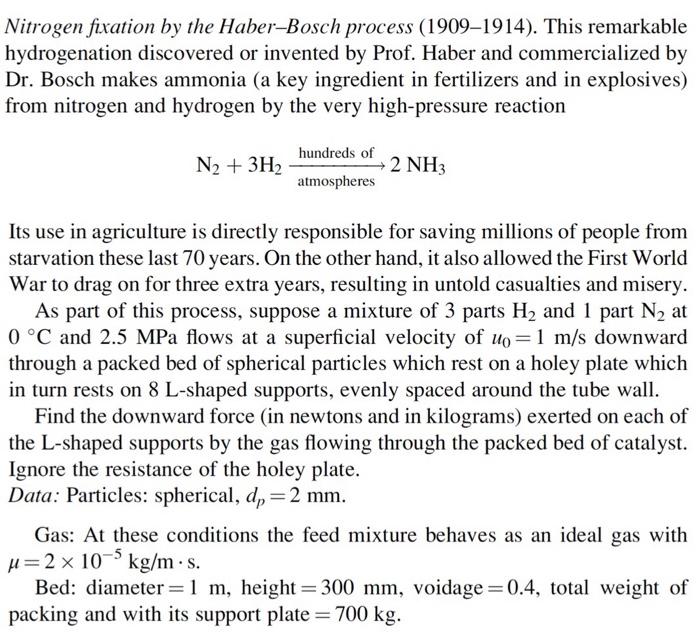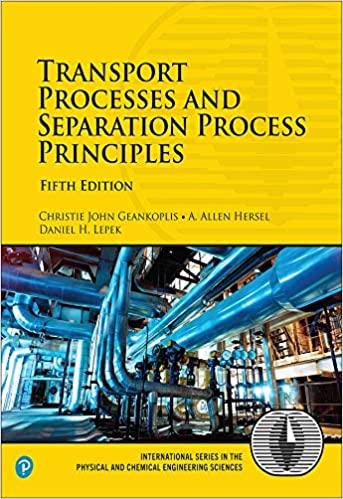Help

Nitrogen fixation by the Haber-Bosch process (19091914). This remarkable hydrogenation discovered or invented by Prof. Haber and commercialized by Dr. Bosch makes ammonia (a key ingredient in fertilizers and in explosives) from nitrogen and hydrogen by the very high-pressure reaction N2 + 3H2 hundreds of atmospheres 2 NH3 Its use in agriculture is directly responsible for saving millions of people from starvation these last 70 years. On the other hand, it also allowed the First World War to drag on for three extra years, resulting in untold casualties and misery. As part of this process, suppose a mixture of 3 parts H2 and 1 part N2 at 0 C and 2.5 MPa flows at a superficial velocity of uo=1 m/s downward through a packed bed of spherical particles which rest on a holey plate which in turn rests on 8 L-shaped supports, evenly spaced around the tube wall. Find the downward force (in newtons and in kilograms) exerted on each of the L-shaped supports by the gas flowing through the packed bed of catalyst. Ignore the resistance of the holey plate. Data: Particles: spherical, dp = 2 mm. Gas: At these conditions the feed mixture behaves as an ideal gas with u=2 x 10-kg/m.s. Bed: diameter =1 m, height = 300 mm, voidage=0.4, total weight of packing and with its support plate = 700 kg. Nitrogen fixation by the Haber-Bosch process (19091914). This remarkable hydrogenation discovered or invented by Prof. Haber and commercialized by Dr. Bosch makes ammonia (a key ingredient in fertilizers and in explosives) from nitrogen and hydrogen by the very high-pressure reaction N2 + 3H2 hundreds of atmospheres 2 NH3 Its use in agriculture is directly responsible for saving millions of people from starvation these last 70 years. On the other hand, it also allowed the First World War to drag on for three extra years, resulting in untold casualties and misery. As part of this process, suppose a mixture of 3 parts H2 and 1 part N2 at 0 C and 2.5 MPa flows at a superficial velocity of uo=1 m/s downward through a packed bed of spherical particles which rest on a holey plate which in turn rests on 8 L-shaped supports, evenly spaced around the tube wall. Find the downward force (in newtons and in kilograms) exerted on each of the L-shaped supports by the gas flowing through the packed bed of catalyst. Ignore the resistance of the holey plate. Data: Particles: spherical, dp = 2 mm. Gas: At these conditions the feed mixture behaves as an ideal gas with u=2 x 10-kg/m.s. Bed: diameter =1 m, height = 300 mm, voidage=0.4, total weight of packing and with its support plate = 700 kg








